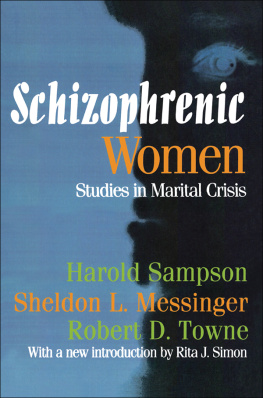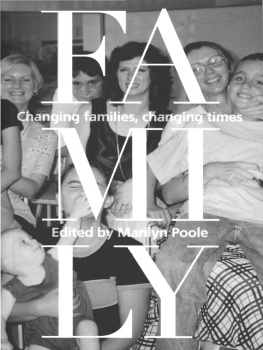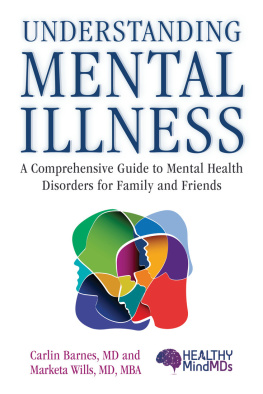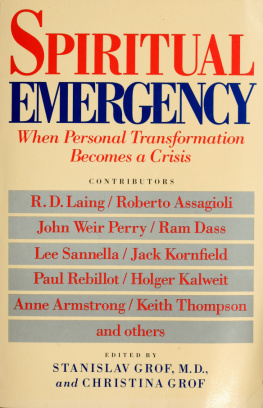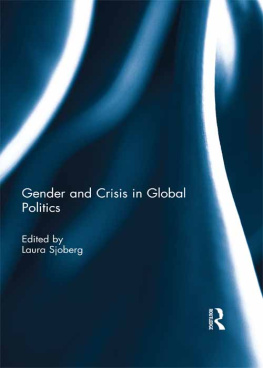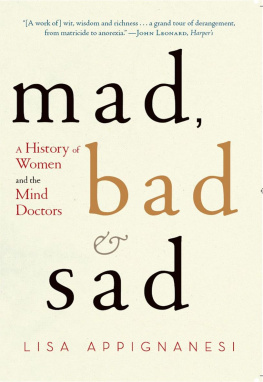Schizophrenic
Women
First published 2005 by Transaction
Publishers Published 2017 by Routledge
2 Park Square, Milton Park, Abingdon, Oxon, OX14 4RN
711 Third Avenue, New York, NY 10017, USA
Routledge is an imprint of the Taylor & Francis Group, an informa business
Copyright 1964 by Prentice-Hall, Inc.
New material this edition copyright 2005 by Taylor & Francis.
All rights reserved. No part of this book may be reprinted or reproduced or utilised in any form or by any electronic, mechanical, or other means, now known or hereafter invented, including photocopying and recording, or in any information storage or retrieval system, without permission in writing from the publishers.
Notice:
Product or corporate names may be trademarks or registered trademarks, and are used only for identification and explanation without intent to infringe.
Library of Congress Catalog Number: 2005048526
Library of Congress Cataloging-in-Publication Data
Sampson, Harold.
Schizophrenic women : studies in marital crisis / Harold Sampson,
Sheldon L. Messinger, and Robert D. Towne ; with a new introduction by Rita J. Simon,
p. cm.
Originally published: New York : Atherton Press, 1964, in series: The
Atherton Press behavioral science series. With new introd.
Includes bibliographical references and index.
ISBN 0-202-30816-2 (pbk. : alk. paper)
1. SchizophreniaCase studies. 2. SchizophrenicsFamily
relationshipsCase studies. 3. WomenMental healthCase studies.
I. Messinger, Sheldon L. II. Towne, Robert D. III. Title.
RC514.S313 2005
362.1968980082dc22
2005048526
ISBN 13: 978-0-202-30816-6 (pbk)
Schizophrenic Women makes a valuable contribution to our understanding of psychotic illness, intrafamily relations, the effectiveness of hospitalization, and the likelihood of complete recovery. It describes the experiences of seventeen families in which the wife and, in some instances, the mother as well, is diagnosed as schizophrenic.
The study focuses not only on the patient but describes in detail the family (husband, maternal and paternal mothers, and children) interactions leading up to the crisis that results in hospitalization.
The authors interviewed the seventeen schizophrenic women, all of whom were admitted at least once to a California state mental hospital in the 1950s, their spouses, the maternal and paternal mothers, the hospital physicians, and in some instances private psychiatrists, over an extended period of time. The average number of interviews for each case was fifty. The interviews were conducted prior to hospitalization, during hospitalization, and following hospitalization.
In addition to the in-depth interviews the study team had access to hospital and other medical records and the opportunity for extensive observations of the intrafamily dynamics. The authors use fictitious names to identify each of the families.
The wives ranged in age from twenty-six to forty; the husbands from twenty-four to forty-five years. The wives mean age was thirty-two; the husbands thirty-five. The women had between one and five children at home. The childrens ages ranged from six months to sixteen years. With the exception of one of the wives, all had at least some high school education, and five had attended college. Three of the husbands had a grammar school education, four attended college, and two received postgraduate degrees. The authors characterize the families as belonging primarily to the upper-lower or lower-middle classes.
How the wives are transformed into mental patients is described in considerable detail. The authors emphasize that becoming a psychiatric patient is not a function simply of being mentally ill but is a socially structured event in which the relationships among the family members play a crucial role. Family ties become increasingly disrupted and in some instances are in permanentjeopardy.
The median length of stay in the state hospital was four months. During their hospitalization all of the women participated in discussion groups, many of them were given drugs, and ten underwent electroshock therapy. None of them were involved in individual psychotherapy. At least six of the women were hospitalized a second time within two years of their first release.
As of the last time the authors had contact with the subjects, seven women were not living in the marital home. Three subjects were, but had been separated at least once following their release from the hospital. Seven women were living in the same family situation continuously since their release. Of those ten women, eight were reported as relatively free of any overt psychotic symptoms.
The appendix provides detailed case studies of the seventeen subjects, including biographical details, data about the families demographics, the changing nature and quality of the marital relationships, the ties to the subjects mothers and mothers-in-law, specifics about the subjects mental illness, the treatments they received, and an assessment of their current mental and family status.
Schizophrenic Women is an exhaustive and illuminating study of the lives of seventeen women who suffered severe psychosis and the treatment they received. It describes not only the forms their illness took but also their changing and disintegrating relationships primarily with their husbands and mothers. Although the study was conducted in the 1950s, readers will recognize its current relevance and importance for scholars and the lay public interested in the problem of mental illness and intrafamily relationships.
RitaJ. Simon
University Professor
American University
This volume is based on the lives of seventeen families that suffered the experiences associated with the hospitalization of the wife and mother for mental illness. A description and analysis of representative experiences is presented in an attempt to provide provisional answers to certain questions: What were the family schemes of livingthe base-line patterns of relatedness, strivings, and adaptationswhich preceded the crises leading to mental hospitalization? How did these schemes of living fall apart? How did personal and family crises become psychiatric emergencies? To what extent and in what ways did hospital experiences modify the immediate crises and the earlier schemes of living? How durable were the reorganized schemes of living fashioned during hospitalization as the patients again moved into the community? Throughout the report a persistent attempt has been made to hold to the aim of placing mental hospitalization and return to the community in the context of ongoing lives. We feel that placing these events in this context is crucial to both understanding and affecting them in a controlled and therapeutic manner. Because this perspective will be emphasized throughout the book, we shall say no more about it here.
But this book is about more than the immediate lives of seventeen women and their families. We have also directed attention to patterns of psychiatric care, to the ways in which such crises as those experienced by these women and their families come to professional attention and are then managed. We have sought to explore how help is found and used and some of the functions hospitalization serves for patients and their families. We have also been concerned to discern some of the ways that traditional patterns of psychiatric care limit our power to observe, understand, and effectively influence a pathological course of events.

